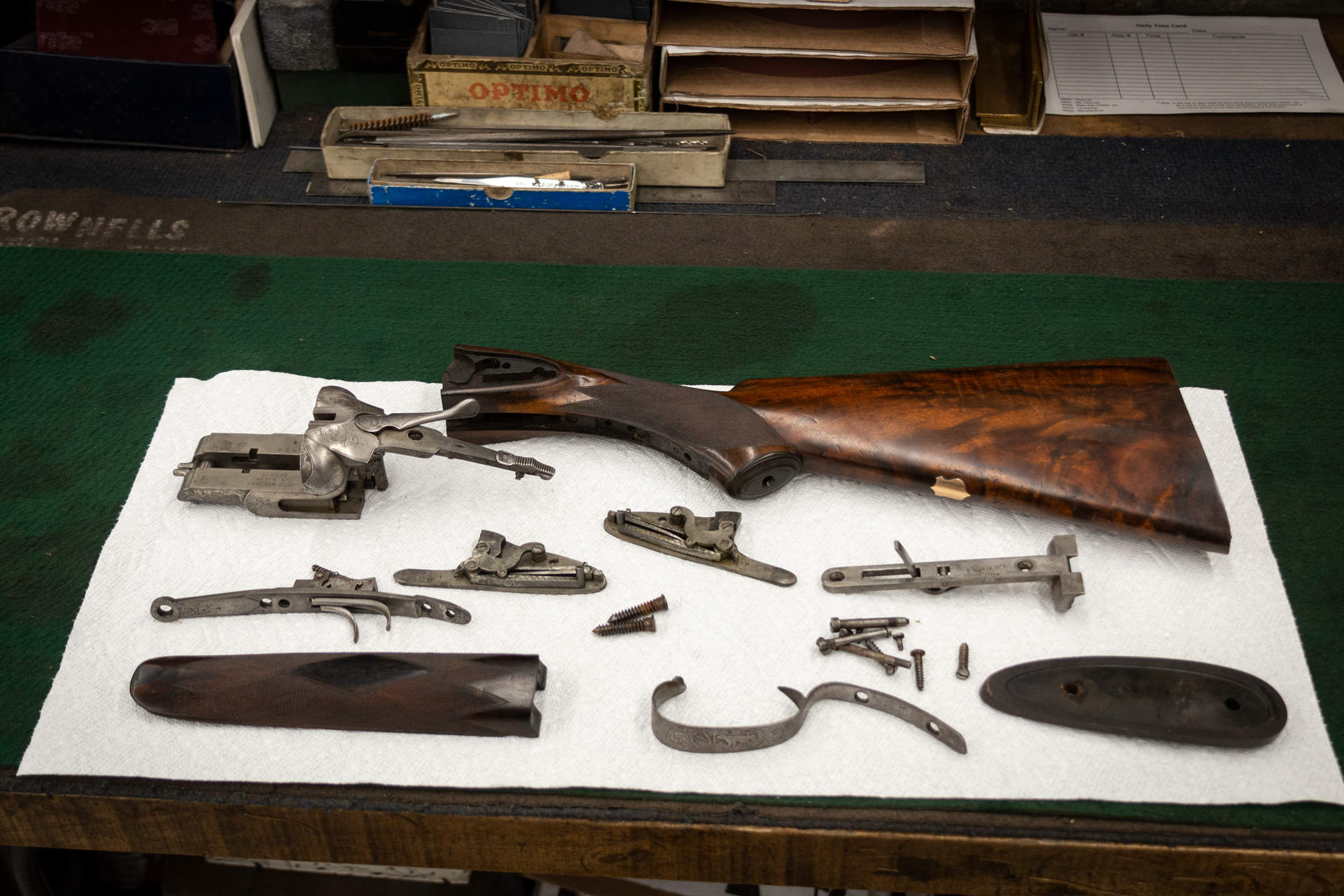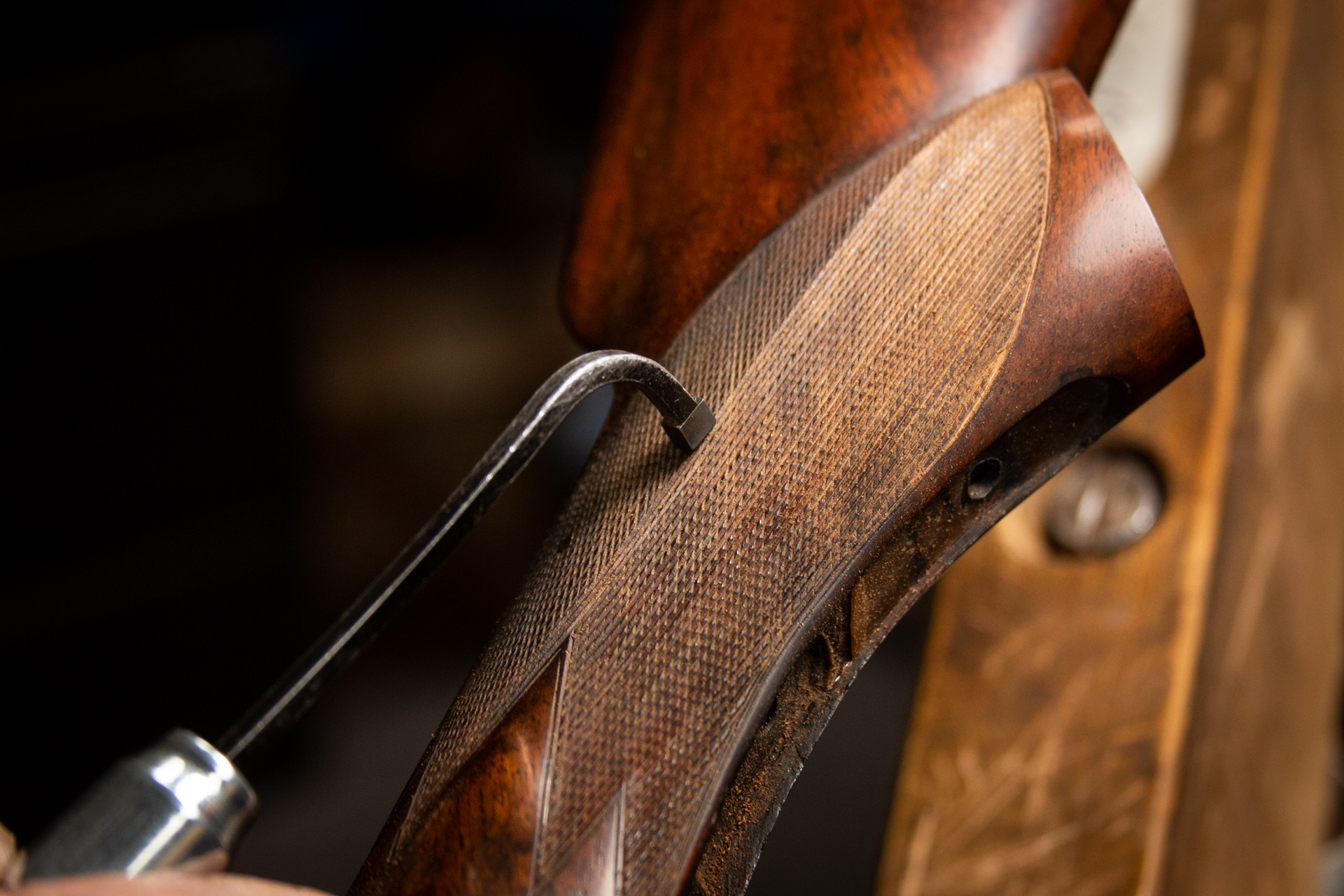To restore, or not to restore? That’s the foundational question to ask yourself when considering what could become a journey to revitalize, or perhaps even resurrect, your classic firearm. A big part of what we do is help our customers understand all the ins and outs of firearm restoration. It may surprise you how much restoration work we decline. That’s because helping our customers arrive at the decision that’s right for them is what’s most important to us.
Below are some of the questions we cover when discussing the pros and cons of firearm restoration. Ready to talk about your restoration project? Click here to start the conversation.
Rarity
Is the firearm rare or unique? If so, is it in the correct configuration, or have pieces and parts been incorrectly replaced or altered over the years? If yes, then it’s best to restore it back to its original configuration. Otherwise, leave it as it is.
History
Does it have specific, historical importance? If so, can you prove it with documentation? Probably best to leave it alone then. Again, if it has parts that have been incorrectly replaced or altered, it may be best to restore it back to its original configuration.
Condition
In what condition is the firearm? If it’s in very good condition, leave it. If it’s not even functioning, or it’s missing important parts, then we might decline the restoration because it’ll be too expensive to restore it.
Investment vs. Sentiment
Would the cost of restoration outpace the value of the restored firearm? If so, it’s up to you whether you want to restore it or not. If it has a lot of personal value, then you might choose to restore it even if you can’t recoup your investment.
Longevity
Do you want to be able to pass down your firearm to future generations? Then it’s probably a good idea to restore it. Restoration improves functioning and condition, effectively resetting the clock on the life of your firearm.
We hope these questions help! We’re here to assist, whether we receive the restoration work or not. So feel free to ask us what we think about your firearm.
Shown: a restored L.C. Smith Grade 4, 10 gauge, originally built in 1920.
Want to See More Stories Like These?
This installment of Restoration Resources appears in our Shoot History e-magazine. If you'd like to see more stories like these while learning about classic firearms preservation, head over to Shoot History. Be sure to hit the subscribe button while you're there.




Couldn’t agree more with Sara. When considering whether to restore a Parker DHE, I went through the same list. The advice I got from Doug was that restoration might cost more than the gun was worth. As a result, I had it restored mechanically to the day it left the factory, but left the exterior alone. In a way, I’m the steward of a classic shotgun that’s brought satisfaction to a century of shooters before me. My responsibility it to ensure that it’s functionally fit for the next owner. You can read about the work Doug and his team did on the DHE in the Jan./Feb. 2019 Sporting Classics. Great people, honest advice, fine workmanship.
If a person decides to go with a total restoration then its best to chose a restorer that has good name recognition and a reputation for getting everything as close to as it left the factory as humanly possible.Going with the best is naturally going to cost more so buy one and cry once and have something you can be proud of instead of something that bothers you every time you look at it. you will be getting more value and satisfaction for your investment in the long run.
Do you mark your restorations? I know Lanara puts an L on the trigger guard. I’ve seen people try to sell his as “all original” and now I see one with a T on the trigger guard which I know Colt never used a T stamp. It’s clearly a testament to the quality of your guys work that it can pass as original. Thanks
Hi Kevin,
Good question. No, we don’t mark our restorations. However, we do keep records of every restoration we complete and we’re happy to look anything up for you. If you or anyone else ever comes across a firearm that looks “too good to be true” feel free to reach out and ask us to look the serial number up!
Thanks,
Sara
I have an 1876 Parker with external hammers, lifter break, and twist barrels. Mechanically it needs a left side firing pin. My biggest concern is can I shoot the gun if I invest in restoring it.
Hi Brian,
A great question. We will only restore firearms that we are also able to make fully operational and safe to shoot. It’s partially to reduce our liability (not a great idea to ship something that’s unsafe to shoot), but also because we believe that restored firearms are made to be used. We’d be happy to take a look at yours for you. If a full restoration isn’t in the budget right now we can also just address the mechanical issues and get it fully functioning again. Feel free to email me at info@turnbullrestoration.com for more information.
Thanks,
Sara
Sara,
This is the perfect article for my buddy who just came upon an 1873 built in 1887. His first thought was buy it and send it to your company. I tried to explain what was written above, but no where near as well as you did. Of course this poses a big problem for me; if after reading this, he has his restored, I’ll have to do mine as well. 😮 Thank you Sara, as usual, always making Monday mornings a bit more tolerable. LOL!!!
We see this in many guesses, if something has a history that can make it unique then leave it alone. Too many people especially in war relics with no actual history as such tend to keep the object virtually as found. Hand grenades are a typical example, there were millions of them produced both in WW 1 and WW 2. More interest would be had if in a condition where it could be restored and is done than just saying it was dug up on the Somme or elsewhere in its original dug up state. The same goes for firearms, if it has sentimental value rather than historic and the cost of refurbishment is not over the top go for it. Millions of pistols, rifles of the same type have been manufactured over the years if the one you have is exactly the same as one you can buy on the open market (and probably in better condition) then refurbishment comes into question. Providing the object has no actual historic value then I will refurbish myself if I think it is necessary and have done many times. There is a huge satisfaction in making something that was an old dog into something delightful to see and hold.
Good stuff. I disagree with restoration of historically significant pieces no matter the condition with one exception. That would be if the piece was recently damaged or recently altered in some capacity and if there was a possibility of restoring it back to its old but predamaged condition.
Finally, there are too many restored pieces by you or others that are being pawned off by the public at large that end up being sold as the genuine authentic untouched item at horrendously inflated prices. Caveat emptor I guess.
Thanks for your thoughts, Jonathan! Yes, it’s really unfortunate that dishonest people will try to pass off a restoration/customization, or even a fake, as something original. As for our restorations, we don’t mark our pieces but we’re always available to look in our database to help a potential customer determine if the firearm they’re looking to buy was restored by us or not. It’s a little thing, but sometimes it helps!
Turnbull has done some work for me in the past and I have been pleased. I’m interested in having an early Baker/L.C.Smith restored. It’s a rather rare quality D from the 1880’s. I don’t currently own the gun but can forward some good quality photos to allow to provide an estimate of the work required. Does this work for you?
Thanks,
Tom S.
Hi Tom,
Thanks for reaching out! We would be happy to take a look at those images for you. Please email them to us at info@turnbullrestoration.com.
Best,
Sara
When it comes to collectibles, I buy to use and enjoy, not for investment. Quite often you can sink far more into a restoration than you will ever recover. I restored a 1965 Ford Mustang Fastback 2+2. I bought a 5 year old example in 1970 that cost me $1K (with financing). I’ve invested around $65K into the one I restored. My 20013 Mustang GT with Boss upgrades cost about $40K. If I sell the 65, I would be lucky to get $30K.
That’s a good point, too, David! That’s one reason we’ll replace parts with high-quality reproduction parts, rather than originals in some instances. Better to have something that’ll function perfectly for years, that you and future generations can go out and use, than something that still doesn’t work perfectly, even after a big investment.
Roughly-speaking, what would an 1878 “Trapdoor” Springfield rifle (with bayonett & bayonett scabbard) cost me to restore? It was issued to my Grandfather Frank in 1899 when he joined the WA. “Home Guard” and was allowed to be given to him when he resigned in 1910. It was given to my father in 1938 and given to me on Thanksgiving Day, 1968. When my son, John III, ever gets a gun safe, it’ll be given to him. It was “arsenal refinished” in 1910, but the wood was not touched.
Hi John,
I’m afraid that’s not a model that we work on. I’d recommend getting in touch with our friend Marc Arena to see if he can help you: 585-233-9990. He works on older firearms like the Springfield you have.
Thanks,
Sara
I am grateful to see that the conversation seriously considers cases where sentimental value drives a restoration, perhaps outweighing all other factors. This acknowledgment understands that “resetting the clock” on a family firearm intended to be passed along just as it has been passed along in the family is of first importance; recouping the investment required to restore such a firearm takes on a very different meaning in such cases.
I have a Remington Model 11 – a “poor man’s American-made Browning A-5.” It has come to me through several generations of my family; it was given to me at age 10 as my first hunting gun. As you can imagine, whatever its market value may be, the gun is priceless to me. I still hunt with it, it shoots perfectly, and it will go to a grandchild when I die. I’d love to investigate restoring this gun.
Hello,
Do you restore old double barrel shot guns? I have a 10Ga with Damascus barrels that I would like to get functional again.
Hi John,
Yes, we do restore old doubles. We’d be happy to take a look at your shotgun for you. We can provide a quote just to repair it, as well as a quote to repair it and fully restore it. Please fill out the form at the following link and include it in the box with your shotgun: https://www.turnbullrestoration.com/wp-content/uploads/2018/04/Quote-Request-Form-040418a.png Let me know if I can answer any other questions for you.
Thanks,
Sara
Do you folks do any work on antique British double rifles (muzzle loader)? Representative photo on page 51 of Donald Dallas book -The British Sporting Gun and Rifle.
Hi Patrick,
No, not really. Our specialties are American side-by-side shotguns, lever-action rifles, and Colt single action revolvers and semi-auto pistols. Within those categories we focus on things made from 1870-1940.
I find the ‘Rarity’ section somewhat ambiguous.
It consists of two questions:
1. Is the firearm rare or unique?
2. Is it [the firearm] in the correct configuration?
The response could be “Yes, Yes,” or “Yes, No,” or “No, Yes,” or “No, No.”
I’m not clear which of the 4 possible responses would justify restoration. Maybe it’s “Yes, No.”
Maybe I dig too deep into things 🙂
Good question! It’s always a case-by-case analysis, but I’d say this:
“Yes, Yes” – Don’t restore
“Yes, No” – Maybe restore. Most likely to be worth the cost to restore.
“No, Yes” – Maybe restore, but may/may not be worth the investment
“No, No” – Maybe restore, but may/may not be worth the investment
Hope that helps!
Sara
I came across this site after finding my great grand uncle’s old Iver Johnson Defender, rusted frozen. 22 caliber, I think. It’s cute, but I don’t have the tools to derust it or otherwise restore it. I haven’t seen anything this small on your restorations page…do you restore these? thank!
Hi Pat,
Yeah, unfortunately that’s not a model we work on.
Thanks,
Sara
Do y’all do any type of work on Browning Auto-5’s? I have a 1988 Japanese made Light Twelve that is in great shape but I also would not mind someone with more skill set breaking it down and replacing any type of worn or overly used part. I also have a Lefever Arms Company A Grade 12 gauge side by side, made in Ithaca, NY (circa 1935-1936). It does not have the original buttpad, but overall it seems to lock up very tight and it appears to function correctly, however I have never shot it before. Is this a model you guys do work on? I would simply want it functioning and a buttpad installed. Thanks again for any information.
Hi Sam,
Thanks for your comment. No, we don’t work on Browning A5s; I would recommend getting in touch with Midwest Gun Works: 636-475-7300. We would work on the Ithaca, though. We focus on side-by-side shotguns, lever-action rifles, and Colt single-action revolvers and semi-automatic pistols. Feel free to send me an email at info@turnbullrestoration.com or give us a call at 585-657-6338 to discuss this potential restoration further.
Thanks,
Sara
Hello, Is a Colt 1903 Pocket Hammerless in .32 ACP Mfg. in 1920 something you would work on? I am in the process of purchasing the pistol and was thinking of restoring it. I have pictures.
Thank you Jim. Colt Pocket Hammerless restorations are feasible. However, for some owners, restoration my not be cost-effective for return-on-investment. It all depends on what you’re trying to achieve. Our “Should I Restore My Old Gun?” blog post is a great place to start. And of course you’re welcome to contact us at quotes@turnbullrestoration.com with photos of the 1903 to start the estimation process.